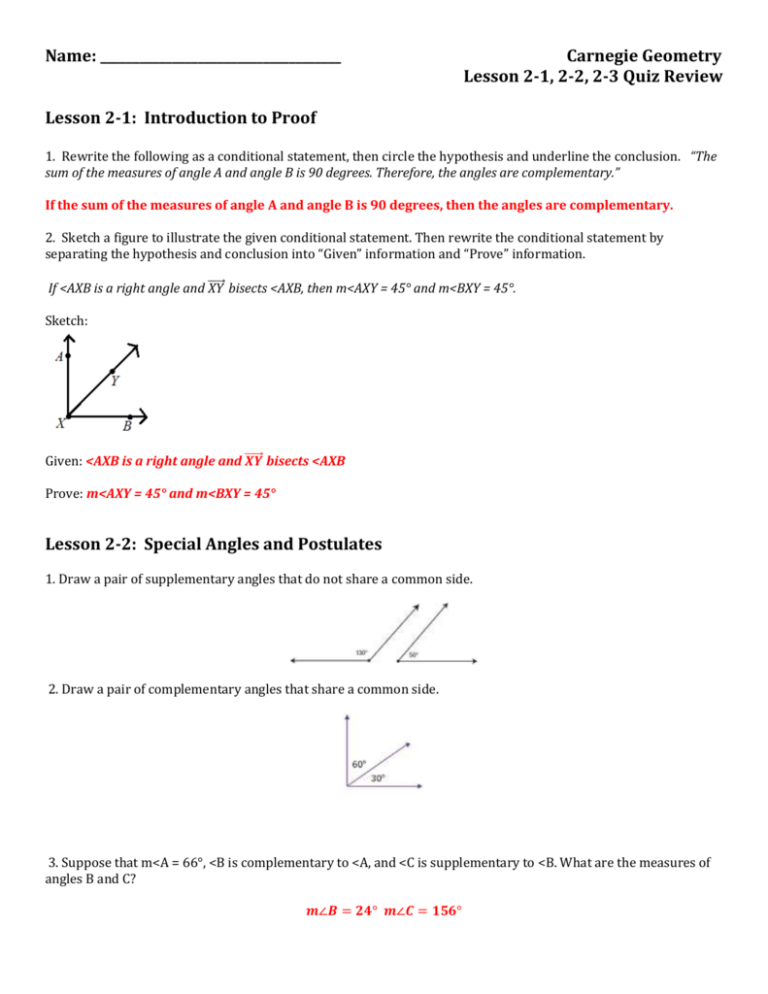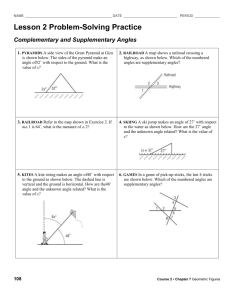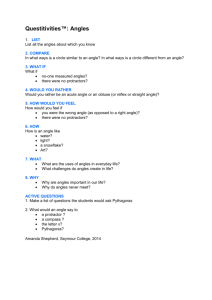Geometry Quiz Review: Proofs, Angles, Postulates
advertisement

Name: _____________________________________ Carnegie Geometry Lesson 2-1, 2-2, 2-3 Quiz Review Lesson 2-1: Introduction to Proof 1. Rewrite the following as a conditional statement, then circle the hypothesis and underline the conclusion. “The sum of the measures of angle A and angle B is 90 degrees. Therefore, the angles are complementary.” If the sum of the measures of angle A and angle B is 90 degrees, then the angles are complementary. 2. Sketch a figure to illustrate the given conditional statement. Then rewrite the conditional statement by separating the hypothesis and conclusion into “Given” information and “Prove” information. If <AXB is a right angle and ⃗⃗⃗⃗⃗ 𝑋𝑌 bisects <AXB, then m<AXY = 45° and m<BXY = 45°. Sketch: ⃗⃗⃗⃗⃗ bisects <AXB Given: <AXB is a right angle and 𝑿𝒀 Prove: m<AXY = 45° and m<BXY = 45° Lesson 2-2: Special Angles and Postulates 1. Draw a pair of supplementary angles that do not share a common side. 2. Draw a pair of complementary angles that share a common side. 3. Suppose that m<A = 66°, <B is complementary to <A, and <C is supplementary to <B. What are the measures of angles B and C? 𝒎∠𝑩 = 𝟐𝟒° 𝒎∠𝑪 = 𝟏𝟓𝟔° 4. The variables x and y in the figure represent the measures of angles. Solve for x and y. 𝒙 = 𝟔𝟑°, 𝒚 = 𝟒𝟓° 5. The variables a and b in the figure represent the measures of angles. Solve for a and b. 𝒂 = 𝟑𝟎, 𝒃 = 𝟏𝟖 6. Name two pairs of adjacent angles in the figure. ∠WVX and ∠XVY, ∠XVY and ∠YVZ, ∠WVY and ∠YVZ, ∠WVX and ∠XVZ 7. What is the difference between two supplementary angles and two angles that form a linear pair? Both supplementary angles and linear pairs have a total of 180°. Linear pairs MUST be adjacent, but supplementary angles do not have to be. 8. Use the figure below to identify each of the following: a) a pair of complementary angles ∠AGB and ∠BGC b) two pairs of supplementary angles There are lots! c) four linear pairs d) two pairs of vertical angles Lots of these, too. ∠BGC and ∠FGE 9. Use the Segment Addition Postulate to create two statements about the figure below: ̅̅̅̅ + 𝒎𝑮𝑱 ̅̅̅ = 𝒎𝑫𝑱 ̅̅̅ + 𝒎𝑱𝑴 ̅̅̅̅̅ ̅̅̅̅, 𝒎𝑮𝑱 ̅̅̅̅ = 𝒎𝑮𝑴 𝒎𝑫𝑮 10. Name the postulate that tells you that m<FGH + m<HGJ = m<FGJ in the figure below: Angle Addition Postulate Sec. 2-3: Forms of Proof 1. Identify the property that justifies each statement: 2. Enter the reasons to complete the two-column proof below: 3. The boxes below show the parts of a flow chart proof. Rearrange the boxes and draw arrows to connect the boxes in a logical sequence to prove the statement. Given: GH = HJ , FG = JK Prove: FH = HK 4. Write the flow chart proof from above as a two column proof: Statements 1. GH = HJ, FG = JK, HJ + JK = HK, FG = GH = FH 2. FG + GH = GH + JK 3. FG + GH = HJ + JK 4. FH = HK Reasons 1. Given 2. Addition Property of Equality 3. Substitution 4. Substitution 5. Vertical Angle Theorem








